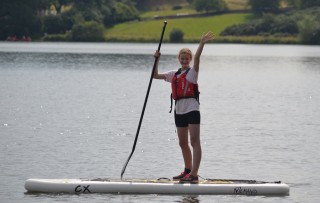How to stand up on a Stand Up Paddle Board?
So, you've seen people having a fantastic time on the water with their stand up paddle board? We hear all the time how people would love to give SUP a go, but, "I just don't have the balance"!
It's true that you do need reasonable balance to stand up on a SUP, but with a few pointers, a little confidence, and some practice, we're sure that, like most people, you'll quickly get to grips with this exciting new pastime.
We find ourselves repeating the same advice to lots of our visitors.
Here are Talkin Adventures' top tips to standing up on a stand up paddle board...
- Begin by getting in the water!
The biggest challenge people face is the fear of getting wet, falling in, or looking silly. Once you realise that it's ok to do any and all of these things then you'll feel much more comfortable and relaxed, and you'll enjoy your experience so much more.
- Get moving!
Ever tried to balance on a stationary bicycle? It's possible, but I'm sure you'd agree that it's much easier to balance on the move. The same is true with Stand Up Paddle Boarding - gain some momentum before you try to stand.
- Look where you want to go!
Quite simply, if you look down at the water, that's where you'll end up! Look ahead at the horizon or a fellow paddler, and keep looking ahead.
- Think about your position.
It might sound pretty obvious, but where your weight is positioned on the board will have a huge impact on your balance. Use the central carry handle as a reference point. Typically, when starting out, most SUP paddlers will aim to stand with their foot pointing forwards, around shoulder width apart, and ever so slightly behind the central handle.
When you're getting ready to stand, there are two common processes.
- Some people will place both hands in front of them on the board, then perform a quick bunny hop and up they go.
- Others may place one foot in front of them, then push up on their knee to bring their other foot to match.
Honestly, I prefer the first, bunny hop, process, but it's not for everyone. If you're less nimble then the latter will likely be more natural. Either way, try and stand in one smooth motion. Think about where you'll end up and move yourself beforehand so that you end up there. I.e. If you're going to end up forward of your starting position, then shuffle back before you start!
It's also worth thinking about where your weight will go as you stand, particularly if you have one foot forward. Try to keep your weight balanced over both sides of the board and near to the central line.
- Not too far apart!
Now then, having your feet positioned far apart will make you feel more stable. That's all very well and good until you shift your weight slightly over one foot. The board will react, then you'll respond, and before you know it there's a disco dance on your board and you're about to end up wet. Having your weight nearer to the centre line of the board will reduce this effect. Shoulder width apart is good and comfortable, or even a slightly offset position with one foot behind.
- Keep hold of the paddle!
While you're moving from a kneeling to a standing position, keep hold of the paddle in one hand. The last thing you want to be doing it leaning back down to pick it up!
- Look ahead and keep moving!
Once you're up, keep your eyes ahead and quickly place another paddle stroke to keep your momentum. Using your paddle will give you some additional stability.
Remember that you're doing this to have fun. If you feel uncomfortable on the board then another paddle stroke might give you some additional stability, or you could simply kneel back down to regroup - that's ok! One trick people use is to place the blade of their paddle on the board in front of them to use it as a support - forming a kind of tripod with their feet and the paddle. Do remember though, although most boards are inflatable, they're not that soft if you land with your hand gripped tightly around a paddle shaft - try to open your grip or let go of the paddle if you're falling onto the board.
Have a great time on the water Folks :)
Comments
By accepting you will be accessing a service provided by a third-party external to https://www.independentadventure.co.uk/

